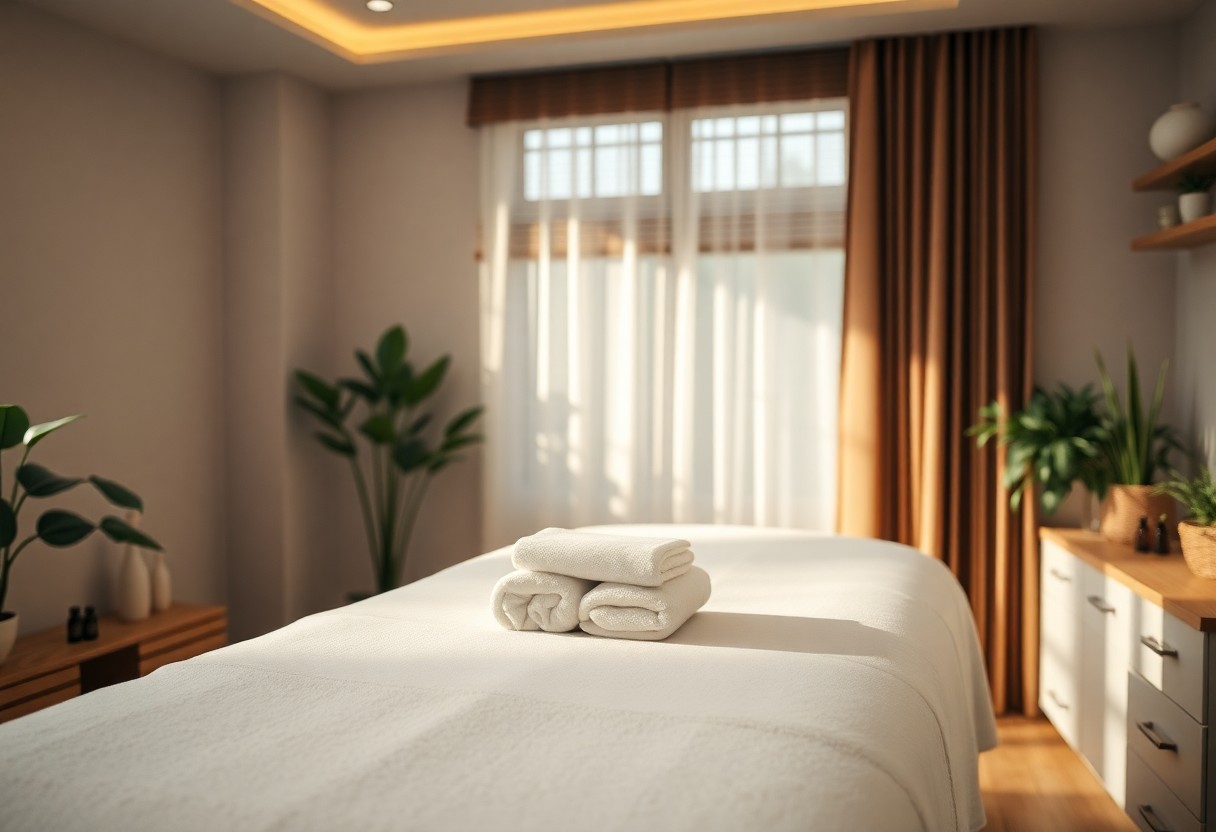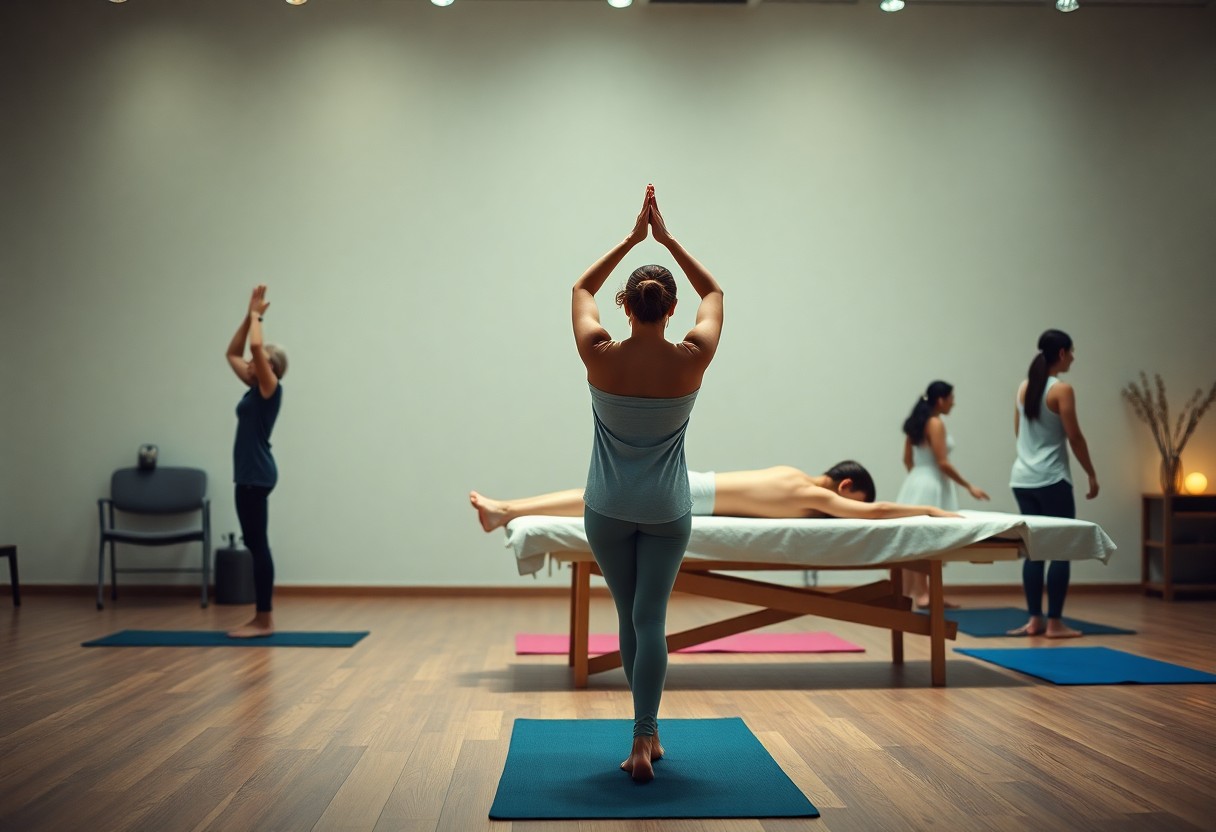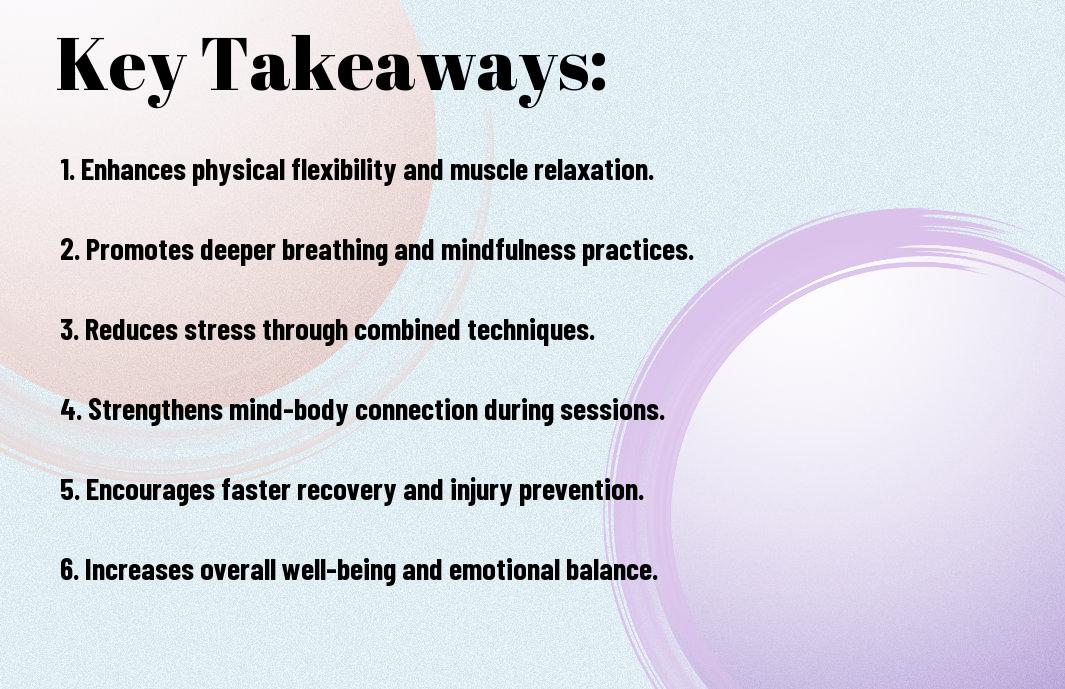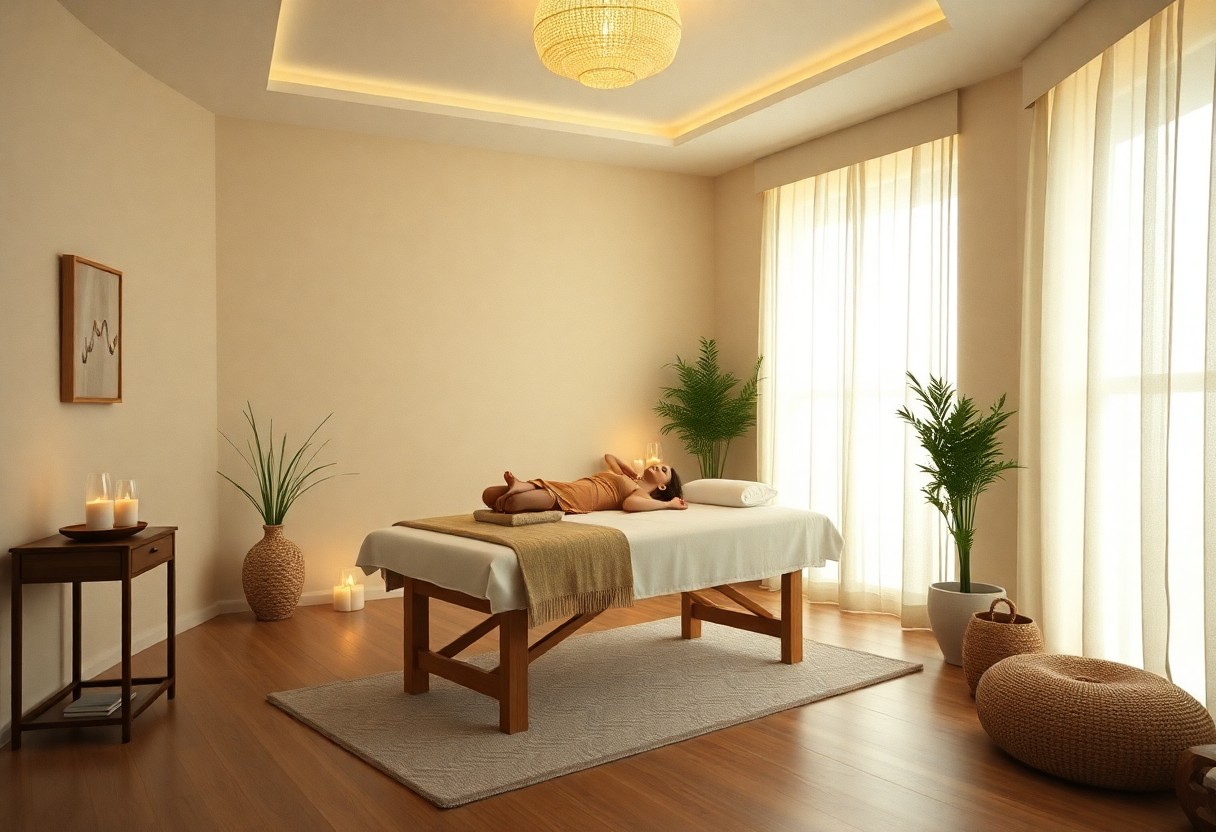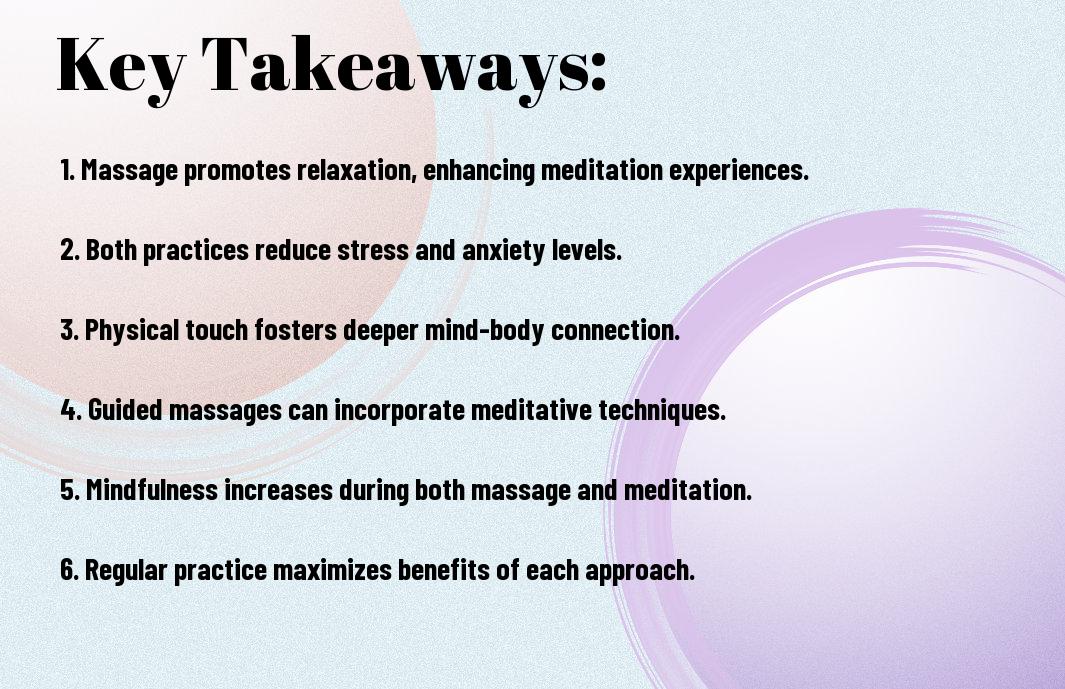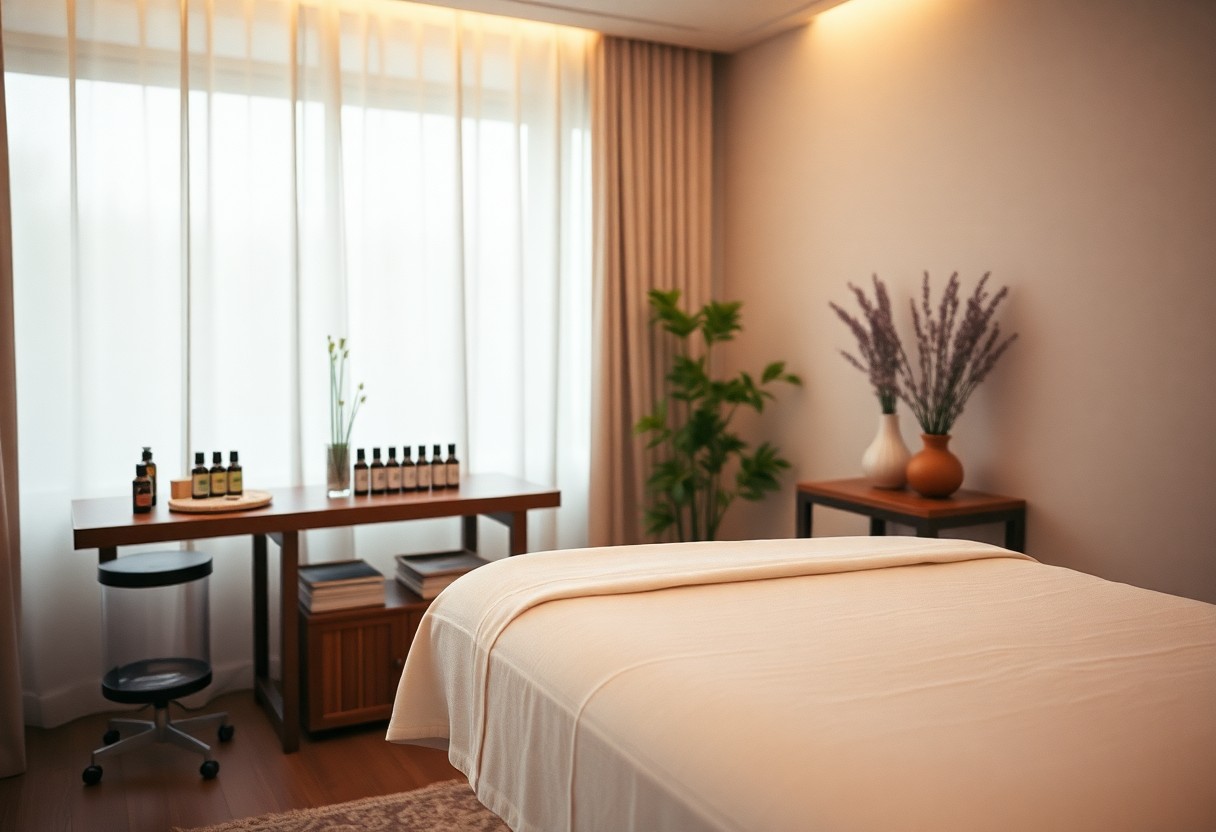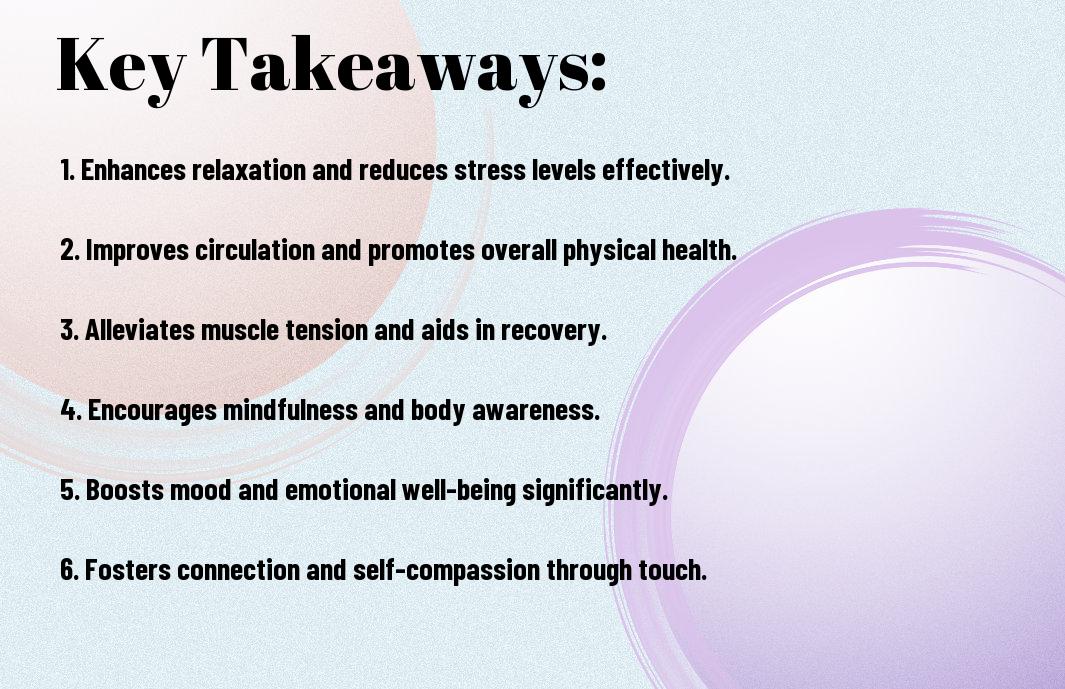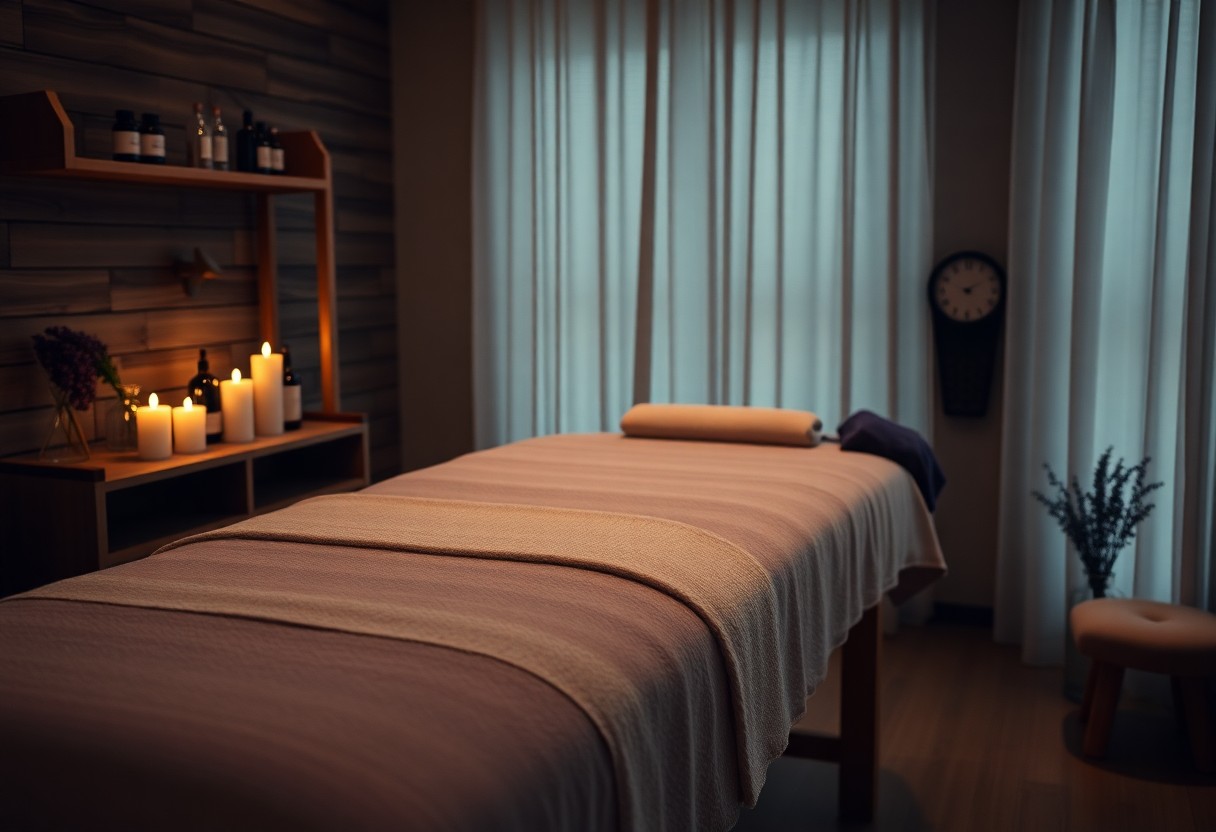Many people seek ways to enhance their overall well-being, and incorporating massage into your holistic wellness routine can be a transformative step. By addressing not only physical tension but also emotional and mental health, massage therapy complements other wellness practices such as nutrition, exercise, and mindfulness. Understanding how massage works in synergy with these elements allows you to create a more balanced approach to caring for your body and mind. Explore the benefits of integrating massage into your self-care regimen and unlock a deeper level of wellness.
Key Takeaways:
- Stress Relief: Massage therapy effectively reduces stress levels, promoting relaxation and mental clarity as part of a comprehensive wellness strategy.
- Enhanced Circulation: Regular massages improve blood flow and circulation, contributing to better overall health and faster recovery from physical exertion.
- Pain Management: Incorporating massage therapy into a holistic routine can significantly alleviate chronic pain and muscle tension, offering a natural alternative to medication.
- Mind-Body Connection: Massage fosters a deeper connection between the mind and body, helping individuals become more in tune with their physical and emotional well-being.
- Improved Flexibility: Regular sessions can enhance flexibility and range of motion, supporting overall physical fitness and reducing the risk of injury.
Understanding Holistic Wellness
While many may view wellness as merely the absence of illness, holistic wellness encompasses a broader spectrum that integrates the physical, emotional, mental, and spiritual dimensions of your life. It encourages a balanced lifestyle, promoting not only physical health but also emotional resilience, mental clarity, and spiritual growth. By embracing holistic wellness, you can cultivate a more fulfilling and harmonious existence.
Definition of Holistic Wellness
Holistic wellness refers to an approach that considers the individual as a whole, emphasizing the interconnectedness of various life aspects—physical, emotional, mental, social, and spiritual. This perspective highlights that well-being is not just about the absence of disease but about thriving and achieving optimal health in every facet of life.
Core Components of Holistic Health
Among the imperative components of holistic health are physical well-being, emotional balance, social connections, mental clarity, and spiritual awareness. Each of these areas contributes to your overall health, highlighting the importance of a multi-faceted approach to wellness.
Wellness involves recognizing that each core component interacts with and influences the others. For instance, engaging in regular physical activity not only improves your bodily health but also enhances your mood and mental sharpness. By nurturing your emotional and social health through meaningful relationships, you build resilience against stress, which in turn supports your physical well-being. Ultimately, achieving a harmonious balance among these elements can lead you to a more enriched and vibrant life.
The Role of Massage in Holistic Health
Some people may overlook massage as a vital component of a holistic health routine. However, it plays a significant role in promoting overall wellness by addressing not just the physical body but also the emotional and mental aspects of your well-being. Incorporating massage into your routine can help create a balanced approach to health, allowing you to thrive in a more holistic manner.
Physical Benefits of Massage
Health professionals widely recognize the various physical benefits of massage therapy. It can alleviate muscle tension, improve circulation, and enhance flexibility, contributing to your body’s overall functionality. Regular sessions can also accelerate recovery from injuries and reduce discomfort in specific areas, helping you maintain a more active and pain-free lifestyle.
Emotional and Mental Wellness through Massage
Massage therapy significantly impacts your emotional and mental wellness. The gentle techniques employed during a session promote relaxation, which can mitigate stress and anxiety. By creating a peaceful environment, massage allows you to connect with your body, fostering a deeper understanding of your emotions.
But the mental benefits of massage extend beyond relaxation. You may find that the soothing effects can lead to enhanced mood and clarity of thought. The release of endorphins during a massage can leave you feeling uplifted, providing a sense of emotional balance that supports your overall mental health. By integrating massage into your wellness routine, you cultivate a space for emotional healing and greater mental resilience.
Integrating Massage into Your Wellness Routine
Many people find that incorporating massage into their wellness routine significantly enhances their overall well-being. By scheduling regular sessions, you can experience both physical and mental benefits, helping to relieve stress, improve circulation, and enhance relaxation. Consider pairing massage with other wellness practices such as yoga or meditation to create a balanced approach to self-care.
Types of Massage Techniques
Types of massage can vary widely, each offering unique benefits to support your wellness routine. Below is a breakdown of some popular techniques:
| Technique | Benefits |
| Swedish | Relaxation and improved circulation |
| Deep Tissue | Targeted relief from muscle tension |
| Hot Stone | Enhanced relaxation and pain relief |
| Aromatherapy | Stress reduction and emotional balance |
| Shiatsu | Balance energy flow and promote healing |
The variety of techniques allows you to choose what best meets your needs and preferences.
Frequency and Timing for Optimal Benefits
Among the keys to maximizing the advantages of massage is understanding its frequency and timing. You should aim for regular sessions, whether weekly or biweekly, to sustain the benefits over time. Listen to your body and adjust based on your lifestyle, stress levels, and any addressing physical issues.
Frequency in your massage schedule can significantly influence its efficacy. Consistency helps your body acclimate to the treatment, promoting deeper relaxation and therapeutic benefits. If you are dealing with high levels of stress or muscle tension, weekly sessions may be more suitable. For routine maintenance or long-term wellness, biweekly or monthly sessions can suffice. Always consider your personal comfort and goals when establishing your frequency, allowing yourself to adapt as necessary.
Choosing a Qualified Massage Therapist
Keep in mind that selecting a qualified massage therapist is vital to maximizing the benefits of your holistic wellness routine. Look for someone who specializes in the type of massage that suits your individual needs, whether that’s deep tissue, Swedish, or another modality. Take your time researching different practitioners, reading reviews, and asking for recommendations to find the right fit for you.
Credentials and Experience
Therapist qualifications often play a significant role in determining the quality of your massage experience. Look for a massage therapist who has completed accredited training programs and holds relevant certifications. Experience matters too; therapists who have worked in various settings tend to be more adaptable and skilled in tailoring sessions to specific concerns. Don’t hesitate to ask about their background and specialties to ensure a secure choice.
Establishing Trust and Comfort
One of the most important aspects of a successful massage is the sense of trust and comfort you feel with your therapist. A positive rapport not only enhances your relaxation but also allows for more effective communication regarding your needs and boundaries.
This trust is built through open dialogue from your first interaction. When you feel comfortable sharing your preferences or concerns, your therapist can adjust techniques to suit your comfort level and therapeutic goals. A compassionate and attentive therapist is key to creating a safe environment where you can fully relax, making your massage sessions more enjoyable and beneficial for your overall wellness journey.
Complementary Wellness Practices
Unlike standalone treatments, integrating massage with complementary wellness practices enhances your overall well-being. By incorporating methods such as nutrition, mindfulness, and physical activity, you can create a balanced approach to your health. These practices work synergistically, helping you to achieve optimal wellness and resilience in everyday life.
Nutrition and Massage
With a focus on nutritional health, you can amplify the benefits of your massage therapy sessions. Consuming a balanced diet rich in vitamins and minerals supports muscle recovery and enhances circulation, allowing your body to respond more effectively to massage. This synergy between nutrition and massage can promote faster healing and increased vitality.
Mindfulness and Stress Management
Nutrition plays a significant role in your emotional and mental health, impacting how you manage stress. When you are mindful of your dietary choices, you can help regulate your mood and energy levels. Practices like meditation and deep breathing techniques can be complemented by massage, creating a holistic approach to stress management that encompasses both body and mind.
For instance, integrating mindfulness meditation before or after your massage can help you fully engage with the experience, promoting deeper relaxation and awareness of your body’s needs. This heightened state of consciousness not only enhances the benefits of the massage but also allows you to better manage stress outside of therapy sessions. By practicing mindfulness, you cultivate resilience and emotional balance, making a lasting impact on your overall wellness journey.
Personalizing Your Holistic Approach
For an effective holistic wellness routine, personalization is key. It allows you to align your practices with your individual needs, preferences, and lifestyle. By integrating various elements that resonate with you, such as nutrition, exercise, and massage, you can create a more balanced and fulfilling approach to wellness. Consider what aspects of your life require more attention and adjust your routine accordingly, ensuring that it serves your unique journey towards well-being.
Assessing Your Unique Needs
Unique to each individual, your wellness needs depend on various factors including your health history, stress levels, and lifestyle. Begin by evaluating how you feel physically and emotionally, pinpointing areas where you seek improvement. Reflect on your daily habits and activities, which can guide you in identifying stressors or imbalances. This assessment will serve as the foundation for tailoring your holistic approach, ensuring that it resonates with your personal wellness goals.
Creating a Balanced Routine
Creating a balanced routine involves incorporating multiple aspects of wellness, including physical, mental, and emotional elements. This balance ensures that you cultivate a well-rounded approach to your overall health. Determine which practices work best for you, whether it’s regular massage sessions, mindful movement, or nutritional adjustments. Emphasizing a variety of activities not only enhances your physical health but also nurtures your mental and emotional well-being, leading to sustainable improvement.
Understanding the importance of balance in your routine encourages you to experiment with different practices, allowing for flexibility and adaptation as your needs evolve. Consider scheduling various activities throughout the week, such as combining massage therapy with yoga and meditation. This approach fosters an engaging and diverse wellness plan that keeps you motivated and open to new experiences. As you discover what resonates most with you, your balanced routine will become an vital pillar of your holistic wellness journey.
Summing up
As a reminder, incorporating massage into your holistic wellness routine can significantly enhance your overall well-being. By addressing physical tension, emotional stress, and promoting relaxation, massage therapy complements other practices like nutrition, exercise, and mindfulness. Prioritizing regular massage sessions allows you to nurture your body, mind, and spirit, helping you achieve a balanced lifestyle. Embrace this healing practice as an integral part of your self-care journey, empowering you to thrive in every aspect of your life.
Q: How does massage therapy contribute to overall well-being?
A: Massage therapy is an integral component of a holistic wellness routine as it promotes physical, mental, and emotional health. Physically, massage helps to alleviate muscle tension, improve circulation, and enhance flexibility. This can lead to reduced pain and improved mobility. Mentally, massage encourages relaxation and stress relief by lowering cortisol levels and increasing serotonin and dopamine, which can enhance mood and mental clarity. Emotionally, receiving regular massage can foster a sense of connection and self-awareness, further supporting an individual’s overall well-being.
Q: Can massage be integrated with other wellness practices?
A: Absolutely! Massage can be seamlessly integrated with various wellness practices such as yoga, meditation, and nutrition. For instance, after a yoga session, massage can help to further release muscle tension and deepen relaxation. Involving massage in a meditation routine can enhance the mind-body connection, allowing for a deeper meditative state. Additionally, the benefits of massage complement a balanced diet by helping the body to recover and absorb nutrients more effectively, facilitating a holistic approach to health. Combining these practices can create a comprehensive strategy for maintaining optimal wellness.
Q: How often should massage be included in a holistic wellness routine?
A: The frequency of massage in a holistic wellness routine can vary based on individual needs, lifestyle, and goals. For general stress relief and maintenance of well-being, scheduling a massage every 2 to 4 weeks may be beneficial. However, for individuals dealing with chronic pain, high-stress levels, or recovering from injuries, weekly or bi-weekly massages could be more appropriate. It’s imperative to listen to your body and adjust the frequency according to your personal wellness goals and how you feel after each session. Consulting with a qualified massage therapist can also provide tailored recommendations.
